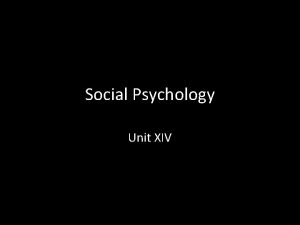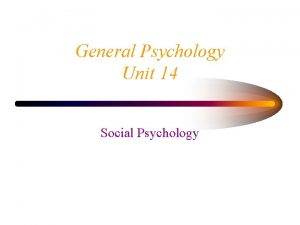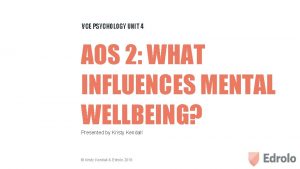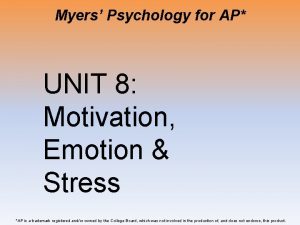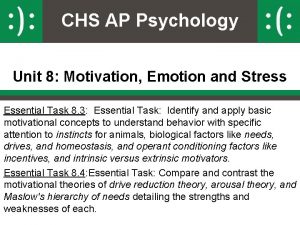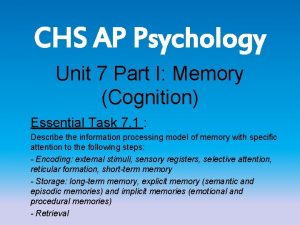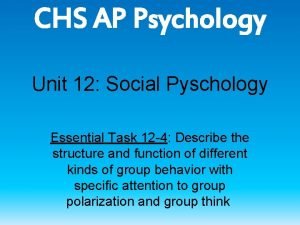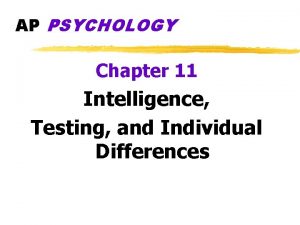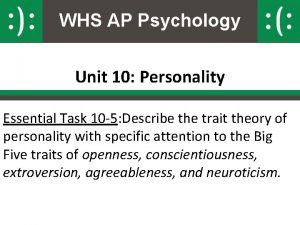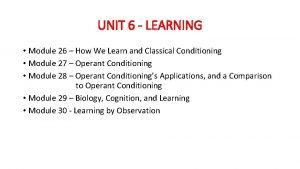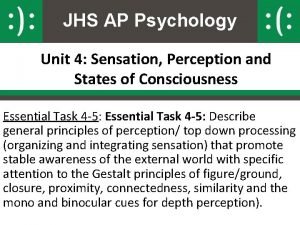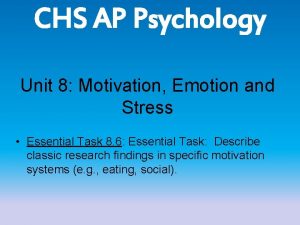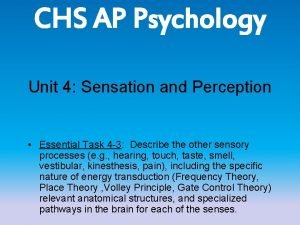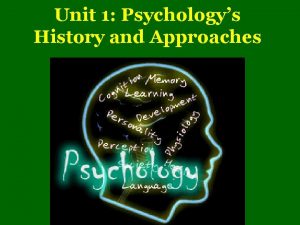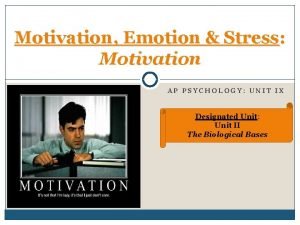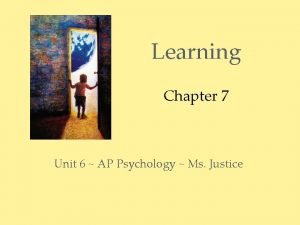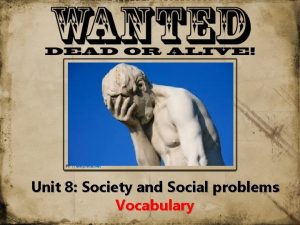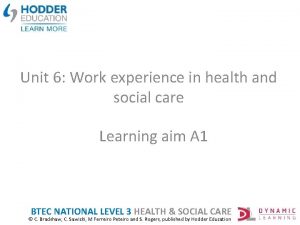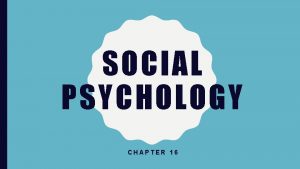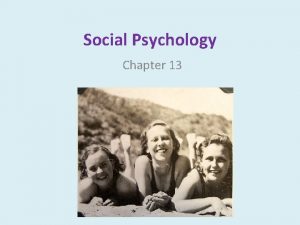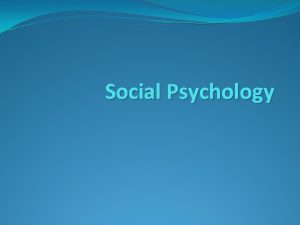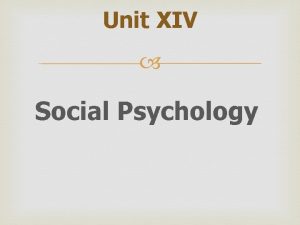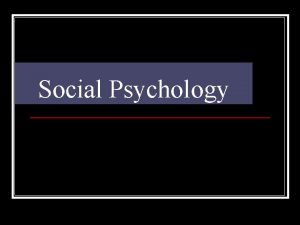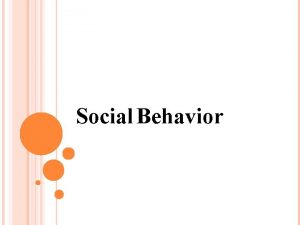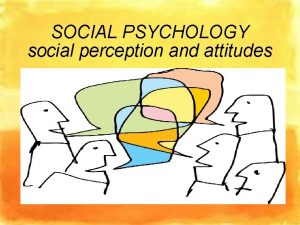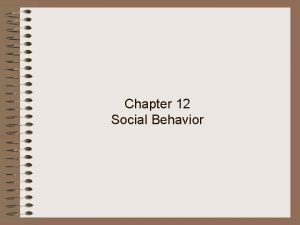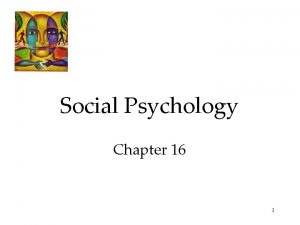UNIT 16 SOCIAL PSYCHOLOGY Social Psychology Social Psychology


























































- Slides: 58

UNIT 16: SOCIAL PSYCHOLOGY Social Psychology • Social Psychology – the scientific study of how we think about, influence, and relate to one another. – What motivates heroic altruism (unselfish regard for welfare of others)? – How do we form our attitudes, and how do those attitudes affect our actions? – What drives people to feel enough hatred to destroy thousands of lives? Attributing Behavior to Persons or Situations • Attribution Theory – theory that we explain someone’s behavior by crediting either the situation or the person’s disposition. – Proposed by Fritz Heider (1958) – Disposition = part of personality – Situation = environment, maybe of stress or abuse

UNIT 16: SOCIAL PSYCHOLOGY Attributing Behavior to Persons or Situations • Fundamental Attribution Error – the tendency for observers, when analyzing another’s behavior, to underestimate the impact of the situation and to overestimate the impact of personal disposition – Fund. Att. Error runs especially strong in individualistic Western cultures, although present in all cultures – Outside our assigned roles as teacher, president, servant, all display fewer of those outgoing characteristics; situation effects how we act – Exception is our own admirable actions, which we tend to attribute to US! – We “blame” behavior on “who someone is” (personality) rather than the situation they are in

UNIT 16: SOCIAL PSYCHOLOGY Attributing Behavior to Persons or Situations • Seeing the world from the “actors” perspective, “observers” better appreciate the situation. • Attribution in Everyday Life: – Was a shooting malicious or in self-defense? – Is another’s friendliness toward us simply kindness or perhaps sexual interest? – THESE HAVE CONSEQUENCES Attributing Behavior to Persons or Situations – Why are people unemployed? • “People get what they deserve” OR • Were they in a bad situation that turned worse? – “Better to drain the swamps than swat the mosquitoes. ” • What does this mean? – Managers tend to attribute poor performance to: • Low ability or lack of motivation – Workers: • Poor working conditions • Difficult co-workers

UNIT 16: SOCIAL PSYCHOLOGY Attitudes & Actions • Attitude – feelings, often influenced by our beliefs, that predispose us to respond in a particular way to objects, people, and events. • Central Route to Persuasion – occurs when interested people focus on the arguments and respond with favorable thoughts • Peripheral Route to Persuasion – occurs when people are influenced by incidental cues, such as a speaker’s attractiveness – Attitudes often predict behavior – Social pressures (external situation) weakens the attitude -behavior link – “Going green” environmental campaign is growing – Also includes responding to endorsements rather than evaluating issues for oneself – This way is more superficial, less durable, and less likely to influence behavior

UNIT 16: SOCIAL PSYCHOLOGY Actions Affect Attitudes • Attitudes sometimes follow behaviors – People will come to believe in the idea they have supported • Foot-In-The-Door Phenomenon – the tendency for people who have first agreed to a small request to comply later with a larger request. Actions Affect Attitudes – “To get people to agree to something big, start small and build. ” – Succumb to a temptation, and you will find the next temptation more difficult to resist – After desegregation laws were established, White Americans expressed diminishing racial prejudice • Attitude followed behavior

UNIT 16: SOCIAL PSYCHOLOGY Role-Playing Affects Attitudes • Role – a set of explanations (norms) about a social position, defining how those in the position ought to behave. • Philip Zimbardo (1972) Stanford Prison Experiment- – When you adopt a new role such as a college student or married person, at first your behaviors will feel phony (because you are acting a role) – Involved male college students assigned to roles as prison guards or prisoners – After two days, the “roles” became very real – Study was called off after only 6 days as the conditions became too extreme – Very similar things happened in real life Abu Ghraib Prison (story on page 678)

UNIT 16: SOCIAL PSYCHOLOGY Role-Playing Affects Attitudes • “What we do, we gradually become. ” – Nathaniel Hawthorne • “Fake it until you make it. ” – Alcoholics Anonymous • “If the King destroys a man, that’s proof to the King it must have been a bad man. ” – Thomas Cromwell • What do these mean? ? ? Role-Playing Affects Attitudes • Person and situation interact – Some people succumb to the situation; others do not • Leon Festinger – Author of the Cognitive Dissonance Theory – Said that when our attitudes and actions don’t coincide, we experience tension, or cognitive dissonance

UNIT 16: SOCIAL PSYCHOLOGY Cognitive Dissonance • Cognitive Dissonance • Example: Theory – theory that we – When our awareness of our attitudes and of our actions act to reduce the discomfort clash, we can reduce the (dissonance) we feel when resulting dissonance by two of our thoughts changing our attitudes. (cognitions) are inconsistent. • “If I chose to do it, I must – To bring relief to this, we often bring our attitudes in line with our actions believe in it. ” • We change our attitudes to help justify the act

UNIT 16: SOCIAL PSYCHOLOGY Cognitive Dissonance • Example: – The main premise for the U. S. to go to war with Iraq was the supposed existence of WMDs in Iraq – When no WMDs were found, the American public shifted justification for the war to “liberating an oppressed people” • We changed our attitudes based on already being in the war Cognitive Dissonance • Changing our behavior can change how we think about others and how we feel about ourselves. • Social Influence – When we know how to act, how to dress, how to groom, etc. , life seems to function smoothly

UNIT 16: SOCIAL PSYCHOLOGY Conformity & Obedience • Conformity – adjusting one’s behavior or thinking to coincide with a group standard. • Behavior is contagious: • Chameleon Effect – term used by Tanya Chartrand John Bargh (1999) to describe humans as natural mimics – Stand gazing upward at sky and others may join you – Bartenders “seed” their tip container – Yawning in contagious – We do this unconsciously – We feel happier around happy people and more depressed around depressed people

UNIT 16: SOCIAL PSYCHOLOGY Conformity & Obedience • Mood Linkage – sharing up and down moods with those around us • Confederates – participants in an experiment who are intentionally told to perform in certain ways so as to influence other participants • Automatic mimicry is part of empathy • Examples: – After 1999 Columbine HS Shooting in Colorado, every U. S. state but Vermont has similar threats of copycat violence – Suicides often increase following a highly publicized suicide

UNIT 16: SOCIAL PSYCHOLOGY Conformity & Obedience – After Saddam Hussein’s death by hanging, there were cases of boys around the world “accidently” hanging themselves Conformity & Obedience • Suggestibility is a subtle type of conformity – We adjust our behavior or thinking to a group standard • Solomon Asch (1955) devised a simple test of conformity: – Among a group of people you don’t know, identify “Which of the three comparison lines is equal to the standard line? ”

UNIT 16: SOCIAL PSYCHOLOGY Abu Ghraib Prison Situation • 2004 Iraqi Prison Incident • Was it the guard’s themselves, or the situation they were placed in? – U. S. military guards • • • Stripped prisoners naked Placed hoods on them Prodded them with electricity Taunted them with attack dogs Deprived prisoners of sleep – U. S. court-martialed and imprisoned some of the guards, but cleared 4 of 5 top commanders responsible for policies and operations – Exhausted working 12 hour shifts, 7 days per week – Dealing with an enemy trained to kill them – Witness to violent deaths of many fellow soldiers • “Atrocious behaviors often emerge from atrocious situations. ”

UNIT 16: SOCIAL PSYCHOLOGY Group Pressure & Conformity • Solomon Asch’s test of conformity • Conformity Increases when: – Asch found that nearly 1/3 of the time, participants were willing to go along with what appeared to be a wrong answer, but conformed to responses made by most others in the group – One is made to feel incompetent or insecure – Group has at least 3 people – Group is unanimous – One admires the group’s status and attractiveness – One has made no prior commitment to any response – Others in group observe one’s behavior – One’s culture strongly encourages respect for social standards

UNIT 16: SOCIAL PSYCHOLOGY Reasons for Conformity • In college residence halls, over time, student’s attitudes become more similar to those living near them. • Informational Social Influence – influence resulting from one’s willingness to accept others’ opinions about reality – Many times it is to avoid rejection and to gain approval • Normative Social Influence – influence resulting from a person’s desire to gain approval or avoid disapproval – Sometimes it pays to accept others’ views as correct, and acknowledge we are wrong • Woman driving on wrong side of British divided highway for 30 miles

UNIT 16: SOCIAL PSYCHOLOGY Reasons for Conformity • Robert Baron and colleagues did a spin off of Asch’s conformity experiment in 1996 • In individualist countries, conformity rates are lower • Tattoos, once a symbol of nonconformity, may lose their appeal if they become too popular • Stanley Milgram (19331984) was a student of Solomon Asch – Briefly flashed observer the picture of a man – Then showed a line-up with 4 men in it, with observing having to identify same man • “IF being right matters, we are receptive to others’ opinions. ” – If outcome seems less important, people rarely conformed to others opinions

UNIT 16: SOCIAL PSYCHOLOGY Obedience • Milgram studied Obedience at Yale University – Specifically studied the effect of punishment on learning – Randomly selected participants to be either “teacher” or “learner” – Teacher would “shock” learner each time they got answer to question wrong – Shocks got progressively stronger Obedience – 63% of participants complied fully, all the way to the last switch – Teachers genuinely displayed distress about the harm they may be causing – Milgram’s use of deception was questioned – Milgram discovered subtle details of situation powerfully influence people

UNIT 16: SOCIAL PSYCHOLOGY Obedience • Obedience was highest when: – Person giving orders was close at hand, and was perceived as legitimate authority figure – Authority figure was supported by prestigious institution – Victim was depersonalized or at a distance (another room) Obedience – There were no role models for defiance; no other participants were seen disobeying the experimenter • This study was most dramatically compared to the situation surrounding the Holocaust; Milgram asked: Could the Holocaust happen again?

UNIT 16: SOCIAL PSYCHOLOGY Lessons from Conformity and Obedience Studies • Both offered a choice between adhering to own standards or being responsive to others • With Milgram (obedience): – Participants torn between moral sense not to harm another person, and obedience to authority – It was kindness vs obedience; obedience usually won Lessons from Conformity and Obedience Studies – “Ordinary people …can become agents in a terrible destructive process. ” – Using foot-in-the-door effect, those who didn’t resist early usually continued all the way – Ordinary people are corrupted by an evil situation

UNIT 16: SOCIAL PSYCHOLOGY Group Influence • How are we influenced by people watching us or joining us in various activities? • Social Facilitation – stronger responses on simple or welllearned tasks in the presence of others – Norman Triplett (1898) noticed that cyclists’ times were faster when competing against other cyclists rather than just against the clock. – Athletes respond to the competition of others, and to an audience – Drivers accelerate faster at a stoplight when another car is beside them

UNIT 16: SOCIAL PSYCHOLOGY Group Influence • On tougher tasks, people perform less well in the presence of others – When others observe us, we become aroused – Arousal strengthens the most likely response: • Correct one on easy task • Incorrect one on difficult task – Home teams in athletics win about 60% of the games Group Influence • When setting up a class or chairs for a gathering, have barely enough seating – When sitting close to one another, like a friendly person even more, and an unfriendly person even less

UNIT 16: SOCIAL PSYCHOLOGY Group Influence • Social Loafing – the tendency for people in a group to exert less effort when pooling their efforts toward attaining a common goal than when individually accountable • Why does social loafing happen? – Especially common among men in individualistic cultures – As part of a group, people feel less accountable and worry less about what others think – As part of a group, people view their contribution as dispensable (group is ok without it)

UNIT 16: SOCIAL PSYCHOLOGY Group Influence • Deindividuation – the loss of self-awareness and selfrestraint occurring in group situations that foster arousal and anonymity – Food fight – Yelling at referee from a crowd – Riot activity Group Influence – Happens when an individual feels aroused anonymous – When wearing a mask or face paint, tribal warriors were more likely than warriors with exposed faces to kill, torture, mutilate, and capture enemies

UNIT 16: SOCIAL PSYCHOLOGY Effects of Group Interaction • Over time, initial differences between groups of college students tend to grow – Differences are amplified over time – Gender differences in behaviors of males and females also tend to grow • Group Polarization – the enhancement of a group’s prevailing inclinations through discussion within the group Effects of Group Interaction – High-prejudice students discussing racial issues become even more prejudiced – Low-prejudice students doing the same thing become more accepting – People today are tending to live near and learn from others with same opinions as they have, thus strengthening those opinions

UNIT 16: SOCIAL PSYCHOLOGY Effects of Group Interaction • Studies have shown that a terrorist mentality does not erupt suddenly • Groupthink – the mode of thinking that occurs when the desire for harmony in a decision-making group overrides a realistic appraisal of alternatives – Usually arises among people who get together because of a grievance and then become more and more extreme as they interact in isolation • Suicide terrorism is virtually never done on a personal whim – It is usually fed by overconfidence, conformity, self-justification, and group polarization

UNIT 16: SOCIAL PSYCHOLOGY Effects of Group Interaction • Key aspects of groupthink: • Groupthink prevented by a leader who: – Examining few alternatives – Selective gathering of information – Pressure to conform within the group, or to withhold criticism – Collective rationalization – Welcomes various opinions – Invites experts’ critiques of developing plans – Assigns people to identify possible problems “None of us is as smart as all of us. ”

UNIT 16: SOCIAL PSYCHOLOGY The Power of Individuals • Committed individuals can sway the majority and make social history. – Example: Rosa Parks and the Civil Rights Movement in the U. S. – Many inventions were thought of as absurd: railroad, typewriter, steamboat, printing press, etc. The Power of Individuals • Minority Influence – the power of one or two individuals to sway majorities – A minority that holds its position is far more successful than one that waffles (back and forth on it’s ideas) • Mahatma Gandhi, Hindu nationalist and spiritual leader, helped India win independence from Britain in 1947

UNIT 16: SOCIAL PSYCHOLOGY Social Relations • What causes us to harm, help, or fall in love? • Prejudice – an unjustifiable (and usually negative) attitude toward a group and its members • Prejudice = Prejudgment • Stereotype – a generalized (sometimes accurate but often overgeneralized) belief about a group of people • Discrimination – unjustifiable negative behavior toward a group and its members – Generally involves stereotyped beliefs, negative feelings, and predisposition to discriminatory action

UNIT 16: SOCIAL PSYCHOLOGY Social Relations • Prejudice = negative attitude • Discrimination = negative behavior • Support for all forms of racial contact has increased • Gender prejudice and discrimination persist – Ex: interracial marriage – Overt racial prejudice still exists – People tend to perceive their fathers as more intelligent than their mothers – Women are more likely to live in poverty – Women have 69% literacy rate whereas men have 83% literacy rate – World has 101 million missing women – China has now declared “sexselective abortions” a criminal offense

UNIT 16: SOCIAL PSYCHOLOGY Social Relations Social Roots of Prejudice • 2/3 of Americans in 2003 preferred to have a male child vs a female child • People tend to prefer slightly “feminized” computer-generated faces • Where does prejudice come from: – Such faces suggest kindness, cooperativeness, etc. – Inequalities – Social Divisions – Emotional Scapegoating • Stereotypes rationalize inequalities – “Women are less assertive, therefore suited for caretaking tasks. ” • Even though not true, it serves to justify historical roles of women in our country

UNIT 16: SOCIAL PSYCHOLOGY Social Roots of Prejudice • Gordon Allport (1954) • Social Identity – what groups we are involved with that help define who we are. • Ironically, we reserve our most intense dislike for outgroup rivals most like us. – Wrote “The Nature of Prejudice” – Being a victim of discrimination can produce self-blame or anger – “Blame the victim dynamic” • EX: if poverty breeds higher crime rates, someone may use the higher crime rate to justify discriminating against those in poverty.

UNIT 16: SOCIAL PSYCHOLOGY Social Roots of Prejudice • Ingroup – “Us” – people with whom we share a common identity. • Outgroup – “Them” – those perceived as different or apart from our ingroup. • Ingroup Bias – the tendency to favor our own group – These predispose prejudices against strangers Emotional Roots of Prejudice • Scapegoat Theory – theory that prejudice offers an outlet for anger by providing someone to blame – 1600 s New England blamed misfortunes on supposed “witches” – People who experience failure or feel insecure will often disparage a rival to boost their status

UNIT 16: SOCIAL PSYCHOLOGY Cognitive Roots of Prejudice • “One seeming antidote to prejudice is intelligence. ” • Other-Race Effect – the tendency to recall faces of one’s own race more accurately than faces of other races. (Also called “cross race effect” and the “own-race bias”) – We feel people of another race all look alike, to some extent Cognitive Roots of Prejudice – We get better at recognizing faces of other races with time • Vivid (violent) cases are readily available in our memory and therefore influence our judgments of a group – We may think of Muslims as terrorists because we know some of the terrorists on 9/11 were Muslims

UNIT 16: SOCIAL PSYCHOLOGY Cognitive Roots of Prejudice • Just-World Phenomenon – the tendency for people to believe the world is just and that people therefore get what they deserve and deserve what they get. – Reflects the view that good is rewarded and evil is punished – In many cases it leads people to think less of the victim – he/she got what they deserved Aggression • Aggression is the most destructive force in social relations • Aggression – any physical or verbal behavior intended to hurt or destroy (this is the psychological definition) – For some, it takes very little to set off aggressive behavior – For others, its very difficult to set off aggressive behavior

UNIT 16: SOCIAL PSYCHOLOGY Biology of Aggression • Biology is influenced at three levels: – Genetic – Neural – Biochemical • Genetic Influences – When one identical twin admits to having a violent temper, the other twin will independently admit the same – Y-chromosome (men) are more aggressive Biology of Aggression • Neural Influences – No one spot in brain controls aggression – Brain as a system will facilitate aggression – Frontal lobes help to inhibit aggression; when damaged, no inhibition – Neurological disorders may be one ingredient in violence – Amygdala is center for emotion in the brain

UNIT 16: SOCIAL PSYCHOLOGY Biology of Aggression • Biochemical Influences – Violent Criminals tend to: • Be muscular young males • Have lower-than-average intelligence scores • Have low levels of neurotransmitter serotonin • Have higher-than-average testosterone levels – High testosterone correlates with irritability, assertiveness, impulsiveness, and a low tolerance for frustration Biology of Aggression – High testosterone also correlates with: • Delinquency • Hard drug use • Aggressive-bullying responses to frustration – With age, testosterone levels drop, and so do these behaviors – Testosterone levels swell in victorious fans at a game; drop in dejected fans

UNIT 16: SOCIAL PSYCHOLOGY Biology of Aggression • Biochemical (continued) – Alcohol tends to focus attention on provocation rather than on inhibitory cues – People who have been drinking commit 4 in 10 violent crimes, and 3 in 4 acts of spousal abuse Psychological & Social-Cultural Factors in Aggression • Suffering may bring out the worst in us – Those made miserable often make others miserable • Frustration-Aggression Principle – the principle that frustration, the blocking of an attempt to achieve some goal, creates anger, which can generate aggression

UNIT 16: SOCIAL PSYCHOLOGY Psychological & Social-Cultural Factors in Aggression • Organisms often respond to stress with a fight-or-flight reaction • Hostility may be evoked by aversive stimuli such as: • People act more hostile when temperatures rise • Learning can alter natural reactions • Ostracism – to be cast outside of a group – – – Physical pain Personal insults Foul odors Hot temperatures Cigarette smoke – Related to rejection-induced aggression – Many times shows itself with school shootings

UNIT 16: SOCIAL PSYCHOLOGY Psychological & Social-Cultural Factors in Aggression • Crime rates are higher (and average happiness is lower) in countries marked by a great disparity between rich and poor • High violence rates exist among cultures and families that experience minimal father care • Aggressive behavior patterns are difficult to change Psychological & Social-Cultural Factors in Aggression • Parenting using aggressive behaviors such as yelling and hitting reinforces those behaviors with the child • Better to reinforce desirable behaviors and frame requests in positive manner

UNIT 16: SOCIAL PSYCHOLOGY Observing Models of Aggression • Viewing X-rated films and internet pornography is higher among males • Rape scenes often depict the victim first fleeing and resisting, but later driven to ecstasy by the perpetrator • Sex offenders report high use of pornography • Repeatedly watching sexually explicit films later makes one’s own partner seem less attractive • Repeated exposure to sexual acts makes sex related acts appear more acceptable – Rape is actually very traumatic, and frequently harms women’s reproductive and psychological health

UNIT 16: SOCIAL PSYCHOLOGY Acquiring Social Scripts • Factors which create a disposition to sexual violence: • Music lyrics provide social scripts • Entertainment used to glamorize drug use, and openly show scenes of torture, mutilation, and sexual coercion. • Entertainment industry now more often portrays the dark side of drug use – – Media Dominance motives Disinhibition by alcohol History of child abuse • Social Scripts – mental tapes of how to act, provided by our culture

UNIT 16: SOCIAL PSYCHOLOGY Video Games & Violence • Interactive games transport the player into their own vivid reality • Grand Theft Auto games simulate running down pedestrian, beating him, and leaving a bloody behind • Grand Theft Auto: San Andreas – – – Carjack vehicle Run down pedestrian Drive-by shooting Pick up prostitute Have sex with prostitute Kill prostitute • Is this teaching a social script?

UNIT 16: SOCIAL PSYCHOLOGY Video Games & Violence • Most abused children don’t become abusive adults • Most social drinkers don’t become alcohol dependent • Most teens who play violent video games don’t become teen assassins • Kids who play a lot of violent video games: – But…desensitization may occur and individual may be more open to violent acts – See the world as more hostile – Get into more fights and arguments – Get worse grades • Violent video games have an even greater effect than violent television shows or movies

UNIT 16: SOCIAL PSYCHOLOGY Video Games & Violence Attraction • Catharsis hypothesis – we feel better if we “blow off steam” by venting our emotions • Three ingredients of our liking for one another: – Not necessarily true – Actually expressing anger breeds more anger, and practicing violence breeds more violence – Proximity – Physical Attractiveness – Similarity • Proximity – geographic nearness – friendship’s most powerful predictor – We are more inclined to like and even marry someone who is geographically near to us

UNIT 16: SOCIAL PSYCHOLOGY Attraction • Proximity (continued) – Repeated exposure to novel stimuli helps – We are even more likely to marry someone whose familiar sounding first or last name sounds like our own – Internet formed friendships are more likely to endure beyond 2 years than those friendships formed in person (Why do you think this is so? ) Attraction • Mere Exposure Effect – the phenomenon that repeated exposure to novel stimuli increases liking of them – “Familiarity breeds fondness” – We trust people whose face most resembles our own, or has some resemblance of us

UNIT 16: SOCIAL PSYCHOLOGY Attraction • Physical Attractiveness • We perceive attractive people to be: – Once proximity has gotten us close, appearance is next important – Physical Attractiveness influences: • • First impressions Frequency of dating Feelings of popularity Others’ initial impressions of their personalities – – – Healthier Happier More sensitive More successful More socially skilled • But NOT: – More honest – More compassionate

UNIT 16: SOCIAL PSYCHOLOGY Attraction • Income • “Beauty is in the eye of the culture” – Those who are plain or obese earn less – Those who are deemed beautiful earn more • Attractiveness is unrelated to self-esteem and happiness – Few people view themselves as unattractive – When less attractive people are praised, they accept it as more sincere, and not a comment on their appearance – Americans now spend more on beauty supplies than on education and social services combined – More and more women feel unhappy about their appearance – Men judge women more attractive if they are youthful in appearance – Women are attracted to healthy looking men (mature, dominant, affluent)

UNIT 16: SOCIAL PSYCHOLOGY Attraction • Symmetrical faces and bodies are more attractive • If we are led to believe someone has appealing traits (honesty, humorous, polite) we tend to find them more physically attractive • Similarity – We tend to NOT like dissimilar people – Friends and couples are far more likely to share common attitudes, beliefs, and interests – “Similarity breeds content” – “Opposites do not attract” – We also like those who like us!

UNIT 16: SOCIAL PSYCHOLOGY Attraction Romantic Love • Reward Theory of Attraction – we will like those whose behavior is rewarding to us and that we will continue relationships that offer more rewards than costs • Two Types of Love • Passionate Love – an aroused state of intense positive absorption in another, usually present at the beginning of a love relationship – Temporary passionate love – More enduring companionate love – Best described by emotional theory that combines physical arousal plus cognitive appraisal – Men aroused by exercise, fright, etc. felt more attracted to their girlfriend – Adrenaline makes the heart grow fonder

UNIT 16: SOCIAL PSYCHOLOGY Romantic Love • Companionate Love – the deep affectionate attachment we feel for those with whom our lives are intertwined – More enduring than the short -lived passionate love – Equity is important – both parties receive in proportion to what they give Romantic Love – Self-Disclosure is important – the revealing of intimate details about ourselves – Writing about your feelings can promote companionate love

UNIT 16: SOCIAL PSYCHOLOGY Altruism • Altruism – unselfish regard for the welfare of others – Hutu militia began to slaughter the Tutsi in 1994 Rwanda – Carl Wilkens, a missionary, risked his life over and over again to see that others could survive – Paul Rusesabagina (a Hutu who was married to a Tutsi) – manager of a luxury hotel – sheltered 1200 Tutsis Bystander Intervention • We will “help” if: – We first notice the incident – We interpret it as an emergency – We assume responsibility for helping • When there is a diffusion of responsibility (when several people have the opportunity to help) any one person is less likely to help.

UNIT 16: SOCIAL PSYCHOLOGY Bystander Intervention • Bystander Effect – the tendency for any given bystander to be less likely to give aid if other bystanders are present. • The best odds of us helping someone occur when: – Person appears to need and deserve help – Person is in some way similar to us Bystander Intervention • Giving help (continued) – We have just observed someone else being helpful – We are not in a hurry – We are in a small town or rural area – We are feeling guilty – We are focused on others and not preoccupied – We are in a good mood

UNIT 16: SOCIAL PSYCHOLOGY The Norms for Helping • Social Exchange Theory – theory that our social behavior is an exchange process, the aim of which is to maximize benefits and minimize costs • Example: donating blood – Costs – time, discomfort, anxiety – Benefits – reduced guilt, social approval, good feelings The Norms for Helping • We tend to be ultimately happier if we donate or spend money on someone other than ourselves • Reciprocity Norm – an expectation that people will help, not hurt, those who have helped them • Social-Responsibility Norm – an expectation that people will help those dependent upon them

UNIT 16: SOCIAL PSYCHOLOGY Conflict & Peacemaking • Conflict – a perceived incompatibility of actions, goals, or ideas • Social Trap – a situation in which the conflicting parties, by each rationally pursuing their self-interest, become caught in mutually destructive behavior Conflict & Peacemaking • Adam Smith – capitalist who wrote The Wealth of Nations (1776) – Non-zero sum game discussed in the movie “A Beautiful Mind” – Social traps involve individuals who feel their small effect on something much larger (environment) won’t make a difference; collectively it makes a difference

UNIT 16: SOCIAL PSYCHOLOGY Enemy Perceptions Contact • Mirror-Image Perceptions – mutual views often held by conflicting people, as when each side sees itself as ethical and peaceful and views the other side as evil and aggressive • In some cases, usually when two parties are of equal status, contact can help resolve conflict – Each party demonizes the other – Each party has similar distorted images of the other – Feed a cycle of hostility, and become self-fulfilling prophecy – EX: two sales clerks having a misunderstanding – Blacks & Whites in South Africa have come to better understand one another – Heterosexual’s personal contact with gay people correlates with accepting attitudes

UNIT 16: SOCIAL PSYCHOLOGY Cooperation • Superordinate Goals – shared goals that override differences among people and require their cooperation • Interracial cooperative learning groups have helped bridge the differences among students in these groups • Idea that “we are all more alike than different” helps • Global Climate Change may be the common bond that unites all humanity – Not only contact, but cooperative contact helps to unite a group – Citizens in U. S. felt more like “Americans” and not part of their smaller cultural group after the 9/11 attacks on the U. S.

UNIT 16: SOCIAL PSYCHOLOGY Communication Conciliation • Understanding and cooperative resolution is most needed, yet least likely, in times of anger or crisis • Charles Osgood (1962, 1980) – social psychologist who advocated a strategy called GRIT. • GRIT – Graduated and Reciprocated Initiatives in Tension-Reduction – a strategy designed to decrease international tensions – Mediators help each of two parties voice their viewpoint and to understand the other’s viewpoint.

UNIT 16: SOCIAL PSYCHOLOGY Conciliation • GRIT (continued) – One side starts by recognizing mutual interests and intent to reduce tension – Opens door for reciprocity by other party – Serves to increase trust and cooperation End of Unit 16 Notes End of Course Notes
 Unit 10, unit 10 review tests, unit 10 general test
Unit 10, unit 10 review tests, unit 10 general test Unit xiv social psychology
Unit xiv social psychology Unit 14 reading guide social psychology
Unit 14 reading guide social psychology Module 79 ap psychology
Module 79 ap psychology Definition of frustration in psychology
Definition of frustration in psychology Social traps ap psychology definition
Social traps ap psychology definition Fundamental attribution error ap psychology
Fundamental attribution error ap psychology Social psychology definition psychology
Social psychology definition psychology Social thinking and social influence
Social thinking and social influence Social thinking adalah
Social thinking adalah Social thinking social influence social relations
Social thinking social influence social relations Metode pembiayaan semi langsung
Metode pembiayaan semi langsung Right triangle trigonometry examples
Right triangle trigonometry examples Si units mass
Si units mass Algebra 2 unit 1 practice test
Algebra 2 unit 1 practice test Unit cost rekam medis
Unit cost rekam medis Unit process and unit operation
Unit process and unit operation What is unit operation and unit process
What is unit operation and unit process Kerangka konseptual standar akuntansi pemerintahan
Kerangka konseptual standar akuntansi pemerintahan Secure vs insecure attachment ap psychology
Secure vs insecure attachment ap psychology Unit 9 developmental psychology
Unit 9 developmental psychology Unit 3 aos 2 psychology
Unit 3 aos 2 psychology Myers ap psych unit 8 vocab
Myers ap psych unit 8 vocab Unit 2 psychology
Unit 2 psychology Ap psychology unit 8 test
Ap psychology unit 8 test Homeostasis ap psychology
Homeostasis ap psychology Psych unit 7
Psych unit 7 Ap psychology unit 12
Ap psychology unit 12 Flynn effect ap psychology
Flynn effect ap psychology Ap psychology unit 14 review
Ap psychology unit 14 review Ap psychology unit 7
Ap psychology unit 7 Ap psychology unit 4
Ap psychology unit 4 Ap psychology unit 4
Ap psychology unit 4 Ap psychology unit 2
Ap psychology unit 2 Ap psychology unit 10
Ap psychology unit 10 Type a personality
Type a personality Ap psychology unit 1 test
Ap psychology unit 1 test Module 26 ap psychology
Module 26 ap psychology Types of perception
Types of perception Unit 8 motivation emotion and stress
Unit 8 motivation emotion and stress Ap psychology unit 4
Ap psychology unit 4 Biofeedback ap psych
Biofeedback ap psych Ap psychology unit 8 test
Ap psychology unit 8 test Authoritariam
Authoritariam Unit 3 vocabulary in context
Unit 3 vocabulary in context Ap psychology unit 3
Ap psychology unit 3 Which drug dampens responsiveness to irrelevant stimuli
Which drug dampens responsiveness to irrelevant stimuli Unit 1 psychology's history and approaches
Unit 1 psychology's history and approaches Unit 1 introduction to psychology
Unit 1 introduction to psychology Unit 1 introduction to psychology
Unit 1 introduction to psychology Ap psychology unit 8 motivation emotion and stress
Ap psychology unit 8 motivation emotion and stress Basic forms of learning
Basic forms of learning Ap psychology behaviorism
Ap psychology behaviorism Ap psychology unit 14
Ap psychology unit 14 Positive psychology ap psychology definition
Positive psychology ap psychology definition Introspection method
Introspection method Health psychology definition ap psychology
Health psychology definition ap psychology Unit 8 society and social problems
Unit 8 society and social problems Btec health and social care level 3 unit 6: work experience
Btec health and social care level 3 unit 6: work experience

